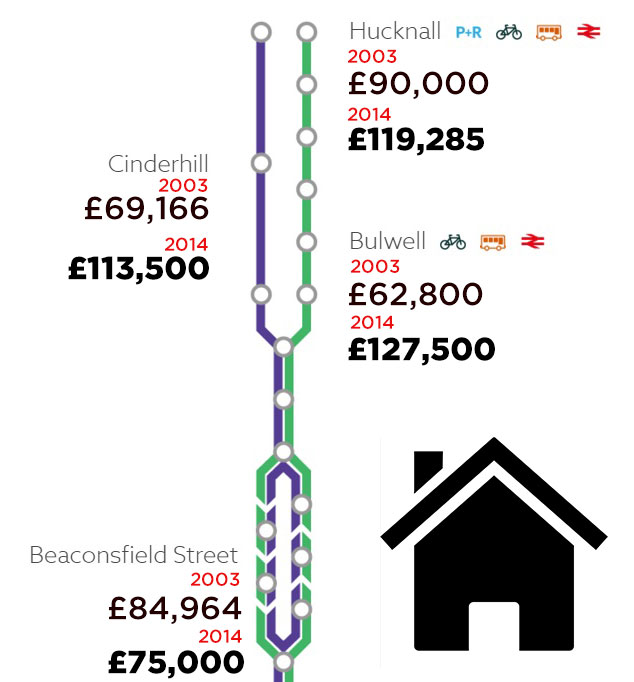
Research by Notts TV News suggests line one of the tram has contributed to a big rise in house prices in parts of Nottingham.
The study of how average sale prices have changed in the ten years since construction focused on residential streets within short walking distances of line one stops.
It shows in most cases prices increased dramatically, with some doubling, in a decade when the average Nottingham house price rose by only £1,464.
The figures add weight to claims the phase two network extension, which opened last year, could help regenerate parts of Clifton and Beeston.
But in a handful of cases house prices along line one have remained broadly similar, or have even decreased slightly, and the survey did not take into account any impact on the prices of homes on streets where the line was run directly along a road, close to a house.
Average house prices near line one stops: 2003 v 2014

In their application to extend the tram network over now-complete phase two, Nottingham Express Transit (NET) were keen to underline economic benefits, saying: “[The tram infrastructure] adds to Nottingham’s appeal as a destination for business, employment, house buyers and attracting visitors.”
Tram route to rising prices?: Where the figures came from
- To conduct the survey Notts TV News worked out the average sale price for a street very close to, but not on, the line at four busy residential areas
- It worked out this figure for each location in 2003 – one year before construction of line one, 2005 – one year after, and 2014 – ten years after
- The data came from Land Registry and RightMove figures
- All but one street showed big increases, significantly above the typical ten-year Nottingham increase of just £1,464
The immediate area around the Bulwell stop noted the biggest rise since 2003 – a £53,334 increase between 2003 and 2014. But in one location – Beaconsfield Street – specifically Burford Road – prices have actually fallen by £10,000.
The average house price for Nottingham city in 2003 was £85,935, which had increased by just £1,464 by 2015.
David Thornhill, of the Nottingham Campaign for Better Transport suggested that the reason for the house price boom was because of young people relocating for work.
He said: “Young people do not want to spend money on a car, so why not have a house near a tram stop, where it is convenient.
“The main benefit of the trams is getting people to and from places of employment – so a tram is a top priority for any company who wants to relocate it’s business; Nottingham is ticking all the boxes and a good public transport system is good for companies and employees.
“Modern housing development and trams go hand in hand in Europe, but in the UK this is yet to come. But there is no doubt we are seeing a start of this in the Nottingham area.”
Prices are a direct effect of the tram
Councillor Jane Urquhart, portfolio holder for planning and housing at Nottingham City Council said: “This is exactly what we expected it is a direct effect of the tram.
“Having a transport system that provides easy access will be a significant attraction to potential buyers.”
Interactive map: How house prices have changed on streets close to key line one stops
When it came to buying a house on tram lines built directly along residential streets the councillor, who is also on the NET Partnership board, said it was matter of choice; like choosing to live on a main road.
She said: “Some people are happy to live on the tram tracks, just as people are happy to live on a main road. It provides them with greater access to transport, and some make this choice and are happy with it.
“We are in conversations with Gedling Borough Council for an opportunity to extend the tram, as well as with HS2 on an opportunity to link Toton with the rail project.”



















